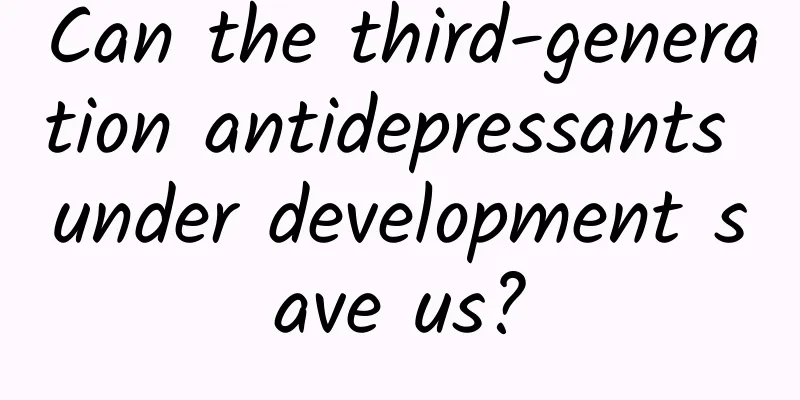Can the third-generation antidepressants under development save us?

|
Yesterday, the news that singer Coco Lee passed away due to depression shocked the entire Internet, and everyone sighed and missed her. Many people find it hard to accept that such a happy, positive and energetic person could not escape the clutches of depression. Humans have never stopped fighting depression. Since the discovery of the first compound with antidepressant effects in 1954, the second-generation antidepressant "Prozac" was approved for marketing in 1988, helping countless patients with depression, but it still cannot meet all treatment needs. Now, the third-generation antidepressants are still under development. I hope the power of science can help all people suffering from depression. Written by | Xu Yixun As far back as 2,500 years ago, Hippocrates of Kos, the father of ancient Greek medicine, and his famous successor Galen of Pergamon, respectively advocated the Four Humors Theory, which has influenced the Western medical community for nearly 2,000 years. Hippocrates believed that humans have four body fluids: blood (sanguine), yellow bile (choleric), black bile (melancholic) and phlegmatic. Health is the result of the harmony of various body fluids. If the body fluids are mixed incorrectly, you will get sick, and the key to treatment is to restore the body fluids to a harmonious state (Figure 1). Galen further applied the Four Humors Theory to clinical practice, dividing people's temperament and constitution into four categories: jaundiced people are brave and energetic, melancholic people are stubborn and melancholic, sanguine people are passionate and decisive, and phlegmatic people are stupid and lazy. Galen also divided inflammation into four types: cellulitis from blood, erysipelas from yellow bile, edema from mucus, and cancer from black bile. He even applied this theory to the classification of fever: continuous fever from blood, three-day fever from yellow bile, daily fever from mucus, and four-day fever from black bile. Figure 1. A passage about the theory of four humors in Hippocrates’ book On the Nature of Man. Source: Jones, WHS (1931) Hippocrates, Volume IV: Nature of Man. Galen can be said to be the peak of the development of Greek medicine. After that, doctors could only annotate or compile the theories of Galen and ancient medicine. Similar to the Yellow Emperor's Classic of Internal Medicine and Treatise on Febrile Diseases, which dominated and constrained the development of traditional Chinese medicine, Western medicine did not create any new opportunities in the next two thousand years. The medical hypotheses obtained by Galen and Hippocrates from clinical and experimental studies became the absolute truth that replaced facts. It was not until after the Renaissance that the new anatomy and cell theory replaced the long-outdated theory of four humors. Although the Western medical community no longer talks about the theory of humors, we can still see the term "melancholia" in medical textbooks, which is undoubtedly a relic of the theory of four humors. The Greek root melan means "black" and cholia means "bile". Melancholia (also spelled as melancholy or melencolia) refers to a disease caused by excessive black bile (Figure 2). It actually describes the depression that plagues nearly 15% of the world's population today. Figure 2. A famous figure print created by German artist Dürer in 1514: Melancolia I Depression is a psychological disorder, also known as affective disorder or affective psychosis. It is a group of emotional disorders characterized by a significant low mood, often accompanied by corresponding changes in thinking and behavior. Depressed patients have painful inner experiences and are "very negative and sad people." The diagnostic criteria for depression proposed by the American Psychiatric Association require that patients show at least five of the nine common symptoms almost every day in the same two-week period: (1) Depression; (2) loss of interest in almost all daily activities; (3) significant weight loss or gain; (4) abnormal insomnia or hypersomnia; (5) psychomotor retardation or anxiety; (6) Fatigue and lack of energy; (7) Negative thinking and total self-denial; (8) decreased brain function or abnormal indecisiveness; (9) Recurrent suicidal thoughts. Figure 3. The pathophysiology of depression involves multiple systems in the human body. [1] Although depression is an emotional disorder of the central nervous system, its pathophysiology also involves several other physiological systems of the human body, including the immune system, the neuroendocrine system involved in stress response (mainly the hypothalamus-pituitary-adrenal axis), the peripheral autonomic nervous system, and the cardiovascular and metabolic systems (Figure 3). Due to the limitations of various animal models of depression, neurobiological studies have not yet clarified the mechanism of interaction between these systems during the disease process. Coincidence and inspiration: the first generation of antidepressants Although the harm of depression to human health has been recorded since ancient Greece, modern medicine has limited means to deal with mental illness until recently. The first compound with antidepressant effect, Iproniazid, was accidentally discovered by several pulmonary clinicians in 1954. This monoamine oxidase (MAO) inhibitor (MAOI) was initially used to try to treat tuberculosis. Clinical trials did not show efficacy, but it was unexpectedly found that Iproniazid had the "side effect" of improving patients' energy. Unfortunately, not long after the success of antidepressant clinical trials and widespread use in patients with depression, Iproniazid was forced to stop using because it was found to be liver toxic. Fortunately, the second antidepressant drug Imipramine developed according to the MAOI idea was soon successful in 1957. It is a compound with a tricyclic structure (Figure 4). Imipramine is effective for 60% to 70% of patients with depression and is still one of the treatment methods used by psychiatrists. Figure 4. Prototype of tricyclic antidepressants: Imipramine Traditional experience in the pharmaceutical industry tells us that many drugs discovered by chance usually have multiple toxic side effects due to their complex mechanisms of action. Patients taking first-generation antidepressants often experience adverse side effects such as rapid and irregular heartbeat, dry mouth, constipation, postural hypotension, drowsiness, etc. In view of this, scientists have continuously synthesized and screened various analogs of Iproniazid and Imipramine in order to reduce these side effects. At the same time, basic medical researchers are also exploring the mechanism of action of these drugs. Since the late 1950s, a large number of neurochemical studies related to depression have been fruitful, leading to the discovery of two monoamine neurotransmitters, norepinephrine and dopamine (Figure 5). Representative scientists Julius Axelrod and Ulf von Euler won the Nobel Prize in Physiology or Medicine in 1970, and Arvid Carlsson won the Nobel Prize in Physiology or Medicine in 2000. Figure 5. The three most important monoamine neurotransmitters: serotonin, dopamine, and norepinephrine Under normal physiological conditions, in order for the postsynaptic neuron to continuously sense the action potential from the presynaptic neuron, the neurotransmitter released from the presynaptic neuron must be removed from the synaptic cleft in a timely and efficient manner after completing the signal conduction. Since the speed at which neurotransmitters leave the synaptic cleft by diffusion is slow, the nervous system has two mechanisms for rapid removal of neurotransmitters, either by using specific metabolic enzymes in the synaptic cleft to degrade them in situ (for example, MAO is an oxidase responsible for degrading monoamine neurotransmitters), or by recycling them through specific transporters on the plasma membrane of presynaptic neurons or glial cells (Figure 6). Figure 6. Presynaptic neurons and glial cells recycle excess neurotransmitters from the synaptic cleft. Source: Luo, L. (2020) Principles of Neurobiology, 2nd Edition. Under the pathological conditions of depression, the efficiency of signal transmission of neurotransmitters related to mood regulation to postsynaptic neurons is likely to be low, and there may be no need to quickly remove them from the synaptic cleft. Subsequent studies along this line of thought have indeed found that MAOIs and tricyclic antidepressants (TCA) can increase the effective concentration of monoamine neurotransmitters in the synaptic cleft. MAOIs can inhibit the activity of MAO enzymes responsible for degrading monoamine neurotransmitters in the synaptic cleft, while TCAs inhibit the nervous system's recycling of norepinephrine and 5-hydroxytryptamine (5-HT, also known as Serotonin). This has led scientists to believe that one of the main pathogenic mechanisms of depression is the significant decrease in the concentration of effectively available monoamine neurotransmitters in the patient's brain. This theory is called the "monoamine hypothesis of depression." A difficult birth: the second generation of antidepressants The monoamine hypothesis of depression successfully promoted the birth of the second generation of antidepressants in the early 1970s. At that time, experiments on Imipramine and two other TCA drugs containing tertiary amines, Amitriptyline and Chlomipramine, showed that their inhibition of serotonin recycling was more than an order of magnitude higher than that of norepinephrine recycling. TCA drugs containing secondary amines, such as Desipramine, Nortriptyline and Desmethylchlomipramine, have the opposite selectivity and can more effectively inhibit the nervous system's recycling of norepinephrine. Therefore, Carlson's laboratory proposed a hypothesis to subdivide the efficacy of TCA. They believed that the inhibition of serotonin recycling can improve the patient's mood (Figure 7), while the inhibition of norepinephrine recycling can increase the patient's interest and motivation for daily activities (Figure 8). Figure 7. Antidepressant mechanism of action of serotonin reuptake inhibitors. Source: Kandel, ER et al (2021) Principles of Neural Science, 6th Edition. Since 1971, researchers at Eli Lilly have been working on developing more specific selective neurotransmitter reuptake inhibitors (SRIs) than TCA drugs, which can enhance the safety of antidepressants and patients' tolerance to drugs by distinguishing different monoamine transmitter systems. They first synthesized a secondary amine compound called Nisoxetine (LY94939), which can highly selectively inhibit the reuptake of norepinephrine in in vitro cell biochemical experiments. In 1972, they chemically modified one of the two benzene rings of Nisoxetine and surprisingly found that after the introduction of trifluoromethyl at the para position, the newly generated secondary amine compound Fluoxetine is a strong selective serotonin reuptake inhibitor (SSRI)! This shows that the "tertiary amine rule" found in TCA does not apply to this type of double benzene ring compound, and the trifluoromethyl group is a key group. If it is replaced with methyl, methoxy, or simple halogen, the effect of inhibiting 5-hydroxytryptamine reuptake will be reduced. If the trifluoromethyl group is moved to the ortho or meta position, in addition to the decrease in the effectiveness of inhibiting 5-hydroxytryptamine reuptake, the inhibitory effect on norepinephrine reuptake is increased. Figure 8. Antidepressant mechanism of norepinephrine reuptake inhibitors. Source: Kandel, ER et al (2021) Principles of Neural Science, 6th Edition. Subsequently, animal pharmacology experiments confirmed the specific inhibition of Fluoxetine on serotonin recycling, so in 1974, researchers at Eli Lilly decided to publish these experimental results in the literature first, and Fluoxetine became the first officially reported SSRI (Figure 9). They believed that Fluoxetine was not only a useful reagent for studying the physiological and endocrine processes of serotonin neurons, but also likely to become a new type of antidepressant. This view aroused doubts and criticisms from some experts in the academic community, because at that time Fluoxetine did not show obvious effects similar to TCA drugs in commonly used animal models of depression (such as the mouse forced swimming test). Experts firmly believed that the inhibition of norepinephrine recycling was more important in the treatment of depression, and they could not imagine that an almost exclusive 5-hydroxytryptamine recycling inhibitor could be used as a clinical antidepressant. Some even believed that enhancing the neural signal transmission of 5-hydroxytryptamine might even deepen the patient's depressive symptoms. Figure 9. Eli Lilly developed a new drug, Fluoxetine, through the gradual optimization of medicinal chemistry, which is now the famous Prozac. [5] Fortunately, Eli Lilly's leadership in the early 1970s was quite pioneering and adventurous, and they approved the establishment of a Fluoxetine product development project. The company first conducted toxicology tests on rats and dogs, and soon found that the animals showed intracellular phospholipid accumulation (phospholipidosis) after taking the drug, which is now commonplace in the toxicology community. Toxicologists at the time were still in an unknown state about the toxicity that phospholipid accumulation might indicate, so the Eli Lilly team was forced to suspend the Fluoxetine project to discuss countermeasures. Nine months later, Eli Lilly scientists went to the neuropharmacology department of the US FDA to consult with relevant experts and learned that many cationic amphiphilic molecules can cause reversible phospholipid accumulation. The good news for Eli Lilly's development project was that many drugs that had been approved for marketing at the time could cause phospholipid accumulation in animals, but had no adverse side effects when used in humans. Therefore, the Fluoxetine development project was restarted, and a phase I clinical trial on the safety performance of the drug began in 1976. The patient's tolerance dose range for Fluoxetine was satisfactory. However, the Phase II clinical trial of Fluoxetine for depression encountered great difficulties. Fluoxetine was not a key project of Eli Lilly at that time, so the number of volunteer patients was insufficient, and the company lacked a leader with rich clinical experience in the field of psychiatric drug development. As a result, Fluoxetine had no obvious effect when used in a small group of patients with depression. In addition to feeling frustrated, Eli Lilly scientists carefully consulted some experts and found that many of these patients did not respond to first-generation antidepressants. Therefore, the Eli Lilly team decided not to give up and changed a group of patients to conduct the expensive Phase II clinical trial again in the next two years. This was also the last chance for the entire Fluoxetine project, and success or failure depended on this one try. "Heaven will not let down those who work hard", this trial achieved satisfactory clinical results, which confirmed the importance of using statistics to guide reasonable experimental design before clinical testing. The Eli Lilly team quickly followed up with a victory and reported another good news in the Phase III clinical trial of large-scale efficacy testing. In addition, they found that compared with TCA drugs, Fluoxetine had much lower clinical side effects, and patients had less adverse reactions such as dry mouth, dizziness, constipation, and drowsiness. In 1983, more than 100 volumes of clinical trial data, each two inches thick, were finally shipped from Eli Lilly's headquarters in Indiana, USA to the FDA's New Drug Approval Department in Washington, D.C. This was seven years after the first human trial of Fluoxetine, which shows the difficulty of developing a new drug. Four years later, during the Christmas holiday, on December 29, 1987, Eli Lilly team members finally learned the good news of Fluoxetine being approved by the FDA on TV news. After more than a decade of hard work, everyone was excited and felt like they had been "vindicated." For a long time, Eli Lilly's project was not favored and was even ridiculed by some industry insiders. In January 1988, Fluoxetine was launched in the United States under the trade name "Prozac", and its market share quickly surpassed that of TCA antidepressants. In 1992, Prozac's sales in the US market alone exceeded the billion-dollar mark. As the first SSRI antidepressant to be marketed, the huge success of Prozac attracted other pharmaceutical companies to follow similar ideas. In 1992, Pfizer's Zoloft became the second SSRI to be marketed. Soon, various new SSRIs emerged and became the second generation of antidepressants that still dominate the market. In 1999, Prozac, the "chief representative" of SSRI drugs, was named "Product of the Century" by Fortune magazine in the United States. The success of the second generation of antidepressants is incomparable to the first generation of drugs represented by TCAs. A long journey: new directions in developing third-generation antidepressants As the second-generation antidepressants are used more and more widely, their limitations and new problems have also begun to attract widespread attention from clinicians. About 20% to 30% of patients with depression still have no effect after at least two different antidepressant treatments. They are classified as treatment-resistant depression (TRD), and their hospitalization rate and suicide risk are much higher than those of ordinary patients. Some patients will relapse after SSRI drugs have achieved efficacy. In addition, there is an unsolved mystery about SSRI antidepressants represented by Prozac: although the patient's blood serotonin concentration increases significantly within a few hours of taking the drug, it takes several weeks or even months of continuous medication to see relief of depressive symptoms. The delayed efficacy suggests that the antidepressant mechanism of SSRI is very complex, and it is not just based on increasing the concentration of serotonin in the synaptic cleft. Since the 1990s, the limitations of the monoamine hypothesis of depression have gradually surfaced. Some scientists have begun to infer that the pathology of depression may also involve intrinsic neural circuits in the cerebral cortex and limbic system, and that neurons in these circuits mainly release two neurotransmitters, glutamate (commonly abbreviated as Glu) and γ-aminobutyric acid (GABA). Glutamate is the most concentrated excitatory neurotransmitter in the brain and is essential for information processing, learning and memory, and neuroplasticity. The process of presynaptic neurons releasing glutamate through vesicles can be negatively regulated by stimulating receptors (GABARs) for the inhibitory transmitter GABA (Figure 10). Figure 10. Glutamate and GABA transmitter signaling under normal physiological conditions [6] The receptor system of glutamate neurotransmitters is relatively complex and can be divided into two major types: (1) ionotropic receptors, mainly including NMDA receptors (NMDAR), AMPA receptors (AMPAR), and kainate receptors; (2) metabotropic receptors (mGluRs). In the late 1990s, studies have shown the antidepressant effect of NMDA receptor antagonists in animal models. Ketamine, an anesthetic approved by the FDA as early as 1970, is actually a highly effective NMDA receptor antagonist. Although ketamine is easily abused and has left the notoriety of the drug "Special K", scientists at Yale University still decided to conduct a double-blind clinical trial of sub-anesthetic doses of ketamine in 7 patients with depression. Unexpectedly, these patients significantly alleviated negative emotions within a few hours after intravenous injection, and the effect could last for several days (Figure 11). Six years later, scholars at the National Institute of Mental Health in the United States further discovered that a single dose of ketamine also had a rapid and sustainable effect on patients with refractory depression. Figure 11. The historical development of ketamine from an anesthetic to an antidepressant [7] In order to develop this anesthetic that is easily abused as a drug into a new drug that can benefit patients with refractory depression, Johnson & Johnson has made arduous efforts and has conducted 19 phase I clinical trials, 4 phase II clinical trials, and 5 phase III clinical trials with the ketamine (S) enantiomer (esketamine) in the form of a nasal spray. In March 2019, the FDA expert committee faced the results of 3 successful phase III trials and 2 failed phase III trials. Considering that there have been no new mechanism antidepressants in the past 30 years, it finally supported the listing of esketamine with an overwhelming majority of 14 votes in favor, 2 votes against, and 1 abstention. The trade name was set as Spravato (Figure 11). The FDA stipulates that Spravato nasal spray must be used in combination with other oral antidepressants and is limited to the treatment of adult patients with refractory depression. In addition, because the product has side effects such as severe drowsiness, dissociative hallucinations, and easy addiction, it needs to be obtained through a special distribution channel (Risk Evaluation and Mitigation Strategy, REMS), accompanied by a corresponding black box warning. Figure 12. Rough molecular mechanism of the antidepressant effects of ketamine and esketamine. 丨Source: The rough molecular mechanism of esketamine is: by antagonizing the NMDA receptors of glutamate, promoting the release of glutamate, and activating the AMPA receptors of postsynaptic neurons. AMPA receptor activation can enhance the signal transduction of neurotrophic factors, thereby producing a rapid and sustainable antidepressant effect (Figure 12). However, these preliminary understandings are still far from our thorough understanding of the mechanism of action of ketamine. In recent years, many scientific research teams have been conducting in-depth research in order to find new drugs that can eliminate the adverse properties of esketamine. There are at least five different hypotheses, and it is difficult for the academic community to reach a comprehensive consensus in the short term. In short, the research and development of antidepressants that are closely related to human brain health still has a long way to go. References [1] Otte, C. et al. (2016) Nature Reviews Disease Primers 2: 16065. [2] Wong, DT, Bymaster, FP & Engleman, EA (1995) Life Sciences 57: 411-441. [3] Stokes, PE & Holtz, A. (1997) Clinical Therapeutics 19: 1135-1250. [4] Wong, ML & Licinio, J. (2004) Nature Reviews Drug Discovery 3: 137-151. [5] Wong, DT, Perry, KW & Bymaster, FP (2005) Nature Reviews Drug Discovery 4: 764-774. [6] Murrough, JW, Abdallah, CG & Mathew, SJ (2017) Nature Reviews Drug Discovery 16: 472-486. [7] Wei, Y., Chang, L. & Hashimoto, K. (2020) Pharmacology, Biochemistry and Behavior 190: 172870 [8] Yavi, M. et al. (2022) Discover Mental Health 2: 9 Produced by: Science Popularization China-Starry Sky Project Copyright statement: Personal forwarding is welcome. Any form of media or organization is not allowed to reprint or excerpt without authorization. For reprint authorization, please contact the backstage of the "Fanpu" WeChat public account. |
<<: International Kissing Day丨8 little secrets about kissing that 99% of people don’t know
Recommend
Those cool little-known facts about WeChat operations, how to promote and operate WeChat
How did you create the above cool and somewhat al...
How to sell out the “Flash Group” flash sale?
In most private domain scenarios, if one-on-one c...
Helicobacter pylori has these "effects"? Don't be complacent, you still have to treat it!
In 1982, Australian scientists Barry Marshall and...
Dropped out of school at 18 and joined Google at 22, chatting and laughing with Jeff Dean. Is a bachelor's degree really necessary?
There are no fixed answers in life, but Chris Ola...
It turns out that restoring your phone to factory settings has such a big impact! Do you understand it? Read it carefully before you proceed
Have you ever restored your phone to factory sett...
I have learned the 8 major factors that affect SEM traffic. If there is no effect, I lose!
Introduction: The most basic factor that determin...
The mosquito that sucked blood is the eyewitness that the criminal never expected
This article comes from the China Science Expo fa...
How did Nobuyuki Idei push Sony into the abyss of decline?
Undoubtedly, Sony has declined, or it can be said...
Tesla's sales in California fall: old cars are not selling well on the eve of launching new cars
According to foreign media reports, according to ...
Apple eats the meat, Android drinks the soup, has the tablet market entered the end game ahead of time?
Not long ago, the well-known market analysis orga...
How to build a private domain operation system where old customers bring in new customers?
There is only one core strategy for the growth of...
Tourism industry advertising unlocks new ways to play with Tik Tok videos!
This article shares with you the May Day holiday ...
Why is toilet paper embossed? It’s because…
Reviewer of this article: Zhou Xiaobo, Doctor of ...
A mysterious area that covers 60% of the Earth hides a new discovery in ecology!
Although human technology has enabled us to trave...









